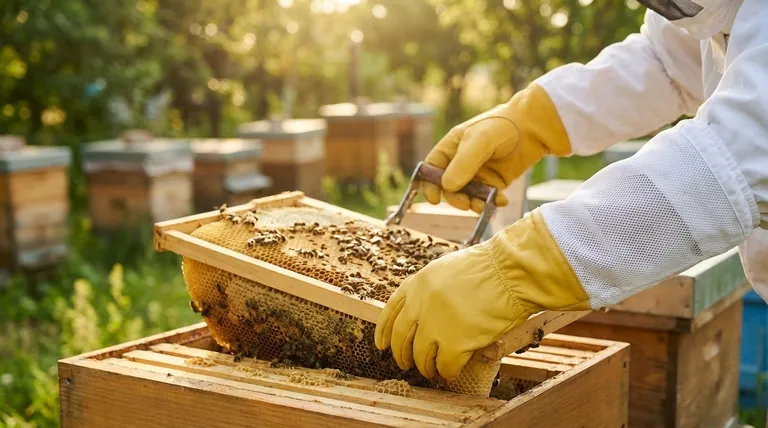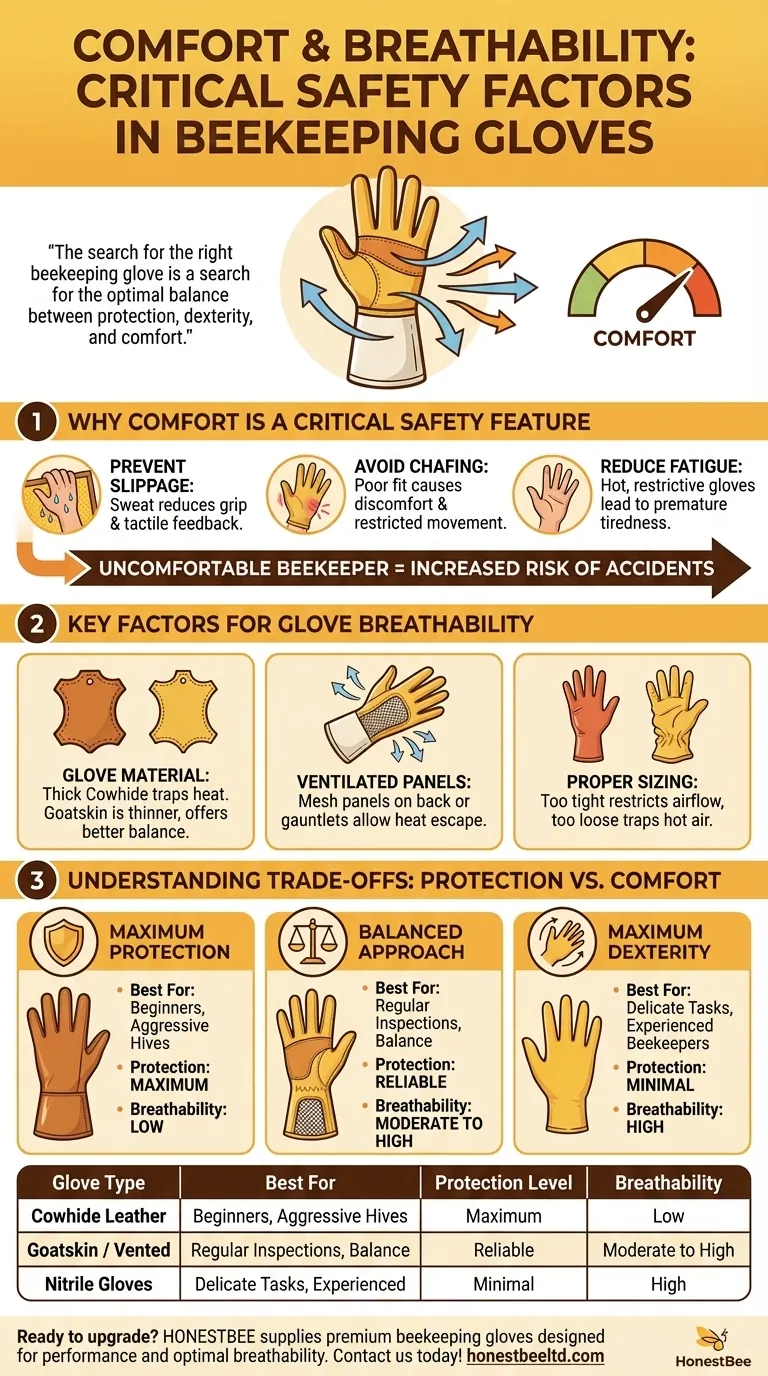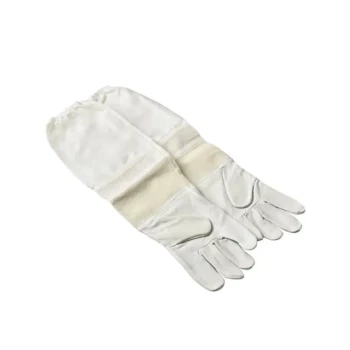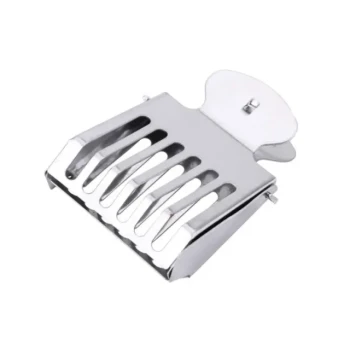For beekeepers, comfort is not a luxury; it is a critical component of safe and effective hive management. For gloves to be comfortable and breathable, they must be made from materials that allow for air circulation or incorporate dedicated ventilated areas. A proper fit is equally important, as it prevents excessive sweating, which can lead to slippage, reduced dexterity, and fatigue during long inspections on hot days.
The search for the right beekeeping glove is a search for the optimal balance between protection, dexterity, and comfort. While protection is non-negotiable, ignoring breathability and fit will directly compromise your safety and effectiveness by causing fatigue and handling errors.

Why Comfort Is a Critical Safety Feature
Thinking of comfort as secondary to protection is a common but dangerous mistake. An uncomfortable beekeeper is an impatient and distracted one, which increases the risk of accidents and poor hive management.
The Problem with Sweat and Poor Fit
When your hands become hot and sweaty, gloves can become slick on the inside. This slippage reduces your grip and tactile feedback, making it harder to handle frames and tools with care.
A poor fit also leads to chafing and restricted movement, causing discomfort that can rush you through a hive inspection. Gloves should be snug enough to feel like a second skin, but not so tight that they cut off circulation or are difficult to remove.
Reducing Fatigue During Long Inspections
Hive inspections require patience and a steady hand. Wearing hot, restrictive gloves is physically draining, leading to premature fatigue.
Breathable, well-fitting gloves mitigate this by keeping your hands cooler and drier. This allows you to work for longer periods without discomfort, enabling more thorough and calm inspections.
Key Factors in Glove Breathability
Breathability is achieved through a combination of material science and glove design. Understanding these factors will help you identify a truly comfortable pair of gloves.
The Role of Glove Material
Different materials offer varying levels of breathability. Thick, heavy-duty cowhide leather provides maximum protection but often traps heat.
Materials like goatskin are thinner and offer a better balance of protection and flexibility, which can indirectly improve airflow compared to stiff leather. However, they are still not inherently breathable.
The Importance of Ventilated Panels
The most direct solution for breathability is active ventilation. Many modern beekeeping gloves incorporate mesh panels, typically on the back of the hands or along the gauntlets (the forearm sleeves).
These panels allow heat and moisture to escape while the more durable leather or synthetic material on the palms and fingers provides the necessary sting protection.
The Impact of Proper Sizing
Even a glove made with breathable materials will feel hot and uncomfortable if it's the wrong size. A glove that is too tight restricts airflow, while a glove that is too loose can bunch up, trapping pockets of hot air and moisture.
Understanding the Trade-offs: Protection vs. Comfort
Choosing a beekeeping glove always involves a trade-off. Your goal is to find the right balance for your specific needs, temperament, and beekeeping style.
Maximum Protection: Cowhide Leather
Thick leather gloves offer the best sting resistance. They are an excellent choice for beginners who need to build confidence or for working with an aggressive hive.
The downside is that they are often hot, stiff, and offer poor dexterity. You sacrifice comfort and "feel" for the highest level of security.
Balanced Approach: Vented or Goatskin Gloves
Goatskin gloves or leather gloves with ventilated panels represent a middle ground. They provide reliable sting protection on the palms and fingers while allowing for much-needed airflow.
This is often the ideal choice for the majority of beekeepers, as it balances safety with the comfort required for regular, lengthy inspections in warm weather.
Maximum Dexterity: Nitrile Gloves
For delicate tasks like marking a queen or handling queen cells, some experienced beekeepers opt for thin, disposable nitrile gloves. These offer virtually no sting protection but provide the greatest dexterity and feel.
This option prioritizes function over protection and should only be considered by calm, confident beekeepers who understand the associated risks.
Making the Right Choice for Your Goal
Your choice of glove should be a deliberate decision based on your priorities and the specific task at hand.
- If your primary focus is maximum protection and confidence as a beginner: Choose thick leather gloves and accept the trade-off in breathability for peace of mind.
- If your primary focus is balancing all-day comfort with reliable protection: Seek out goatskin or leather gloves that explicitly feature ventilated mesh panels.
- If your primary focus is absolute dexterity for delicate tasks: Consider using nitrile gloves for short periods, understanding they offer minimal protection from stings.
Ultimately, the right glove is one you are comfortable wearing, as it empowers you to be a calmer, safer, and more attentive beekeeper.
Summary Table:
| Glove Type | Best For | Protection Level | Breathability |
|---|---|---|---|
| Cowhide Leather | Beginners, Aggressive Hives | Maximum | Low |
| Goatskin / Vented Gloves | Regular Inspections, Balance | Reliable | Moderate to High |
| Nitrile Gloves | Delicate Tasks, Experienced Beekeepers | Minimal | High |
Ready to upgrade your beekeeping operation with gloves that combine safety, comfort, and durability? HONESTBEE supplies commercial apiaries and distributors with premium beekeeping gloves designed for long-lasting performance and optimal breathability. Contact us today to discuss wholesale pricing and find the perfect gear for your needs!
Visual Guide

Related Products
- Beekeeping Gloves Goatskin Leather with Long Cotton Sleeve for Beekeepers
- Goatskin Leather Beekeeper Gloves with Vent Long Sleeve for Beekeeping Honey Bee Sting Proof Protection
- Mesh Ventilated 3 Layer Goatskin Beekeepers Gloves for Beekeeping
- Professional Galvanized Hive Strap with Secure Locking Buckle for Beekeeping
- Heavy Duty Stainless Steel Queen Bee Catcher Clip
People Also Ask
- What are the advantages of goatskin leather gloves for beekeeping? Superior Sting Protection for Your Apiary
- What are the features of ventilated bee gloves? Stay Cool & Dexterous in Warm Weather
- What should beekeepers consider regarding the fit of beekeeping gloves? Achieve Safety and Dexterity
- What is the safest way to handle frames in beekeeping? Master Gentle Handling for a Calm Hive
- Should beekeepers wear gloves, and why? Essential Protection for Beekeepers



















